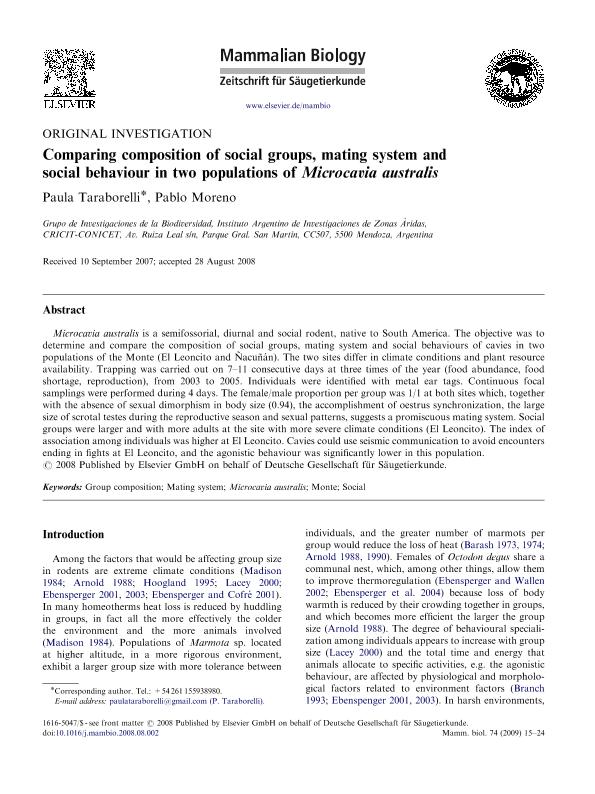Artículo
Comparing composition of social groups, mating system and social behaviour in two populations of Microcavia australis
Fecha de publicación:
01/2009
Editorial:
Elsevier Gmbh
Revista:
Mammalian Biology
ISSN:
1616-5047
Idioma:
Inglés
Tipo de recurso:
Artículo publicado
Clasificación temática:
Resumen
Microcavia australis is a semifossorial, diurnal and social rodent, native to South America. The objective was to determine and compare the composition of social groups, mating system and social behaviours of cavies in two populations of the Monte (El Leoncito and Ñacuñán). The two sites differ in climate conditions and plant resource availability. Trapping was carried out on 7-11 consecutive days at three times of the year (food abundance, food shortage, reproduction), from 2003 to 2005. Individuals were identified with metal ear tags. Continuous focal samplings were performed during 4 days. The female/male proportion per group was 1/1 at both sites which, together with the absence of sexual dimorphism in body size (0.94), the accomplishment of oestrus synchronization, the large size of scrotal testes during the reproductive season and sexual patterns, suggests a promiscuous mating system. Social groups were larger and with more adults at the site with more severe climate conditions (El Leoncito). The index of association among individuals was higher at El Leoncito. Cavies could use seismic communication to avoid encounters ending in fights at El Leoncito, and the agonistic behaviour was significantly lower in this population.
Palabras clave:
Group Composition
,
Mating System
,
Microcavia Australis
,
Monte
,
Social
Archivos asociados
Licencia
Identificadores
Colecciones
Articulos(IADIZA)
Articulos de INST. ARG DE INVEST. DE LAS ZONAS ARIDAS
Articulos de INST. ARG DE INVEST. DE LAS ZONAS ARIDAS
Citación
Taraborelli, Paula Andrea; Moreno, Pablo Gastón; Comparing composition of social groups, mating system and social behaviour in two populations of Microcavia australis; Elsevier Gmbh; Mammalian Biology; 74; 1; 1-2009; 15-24
Compartir
Altmétricas




